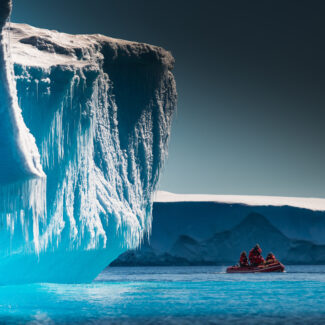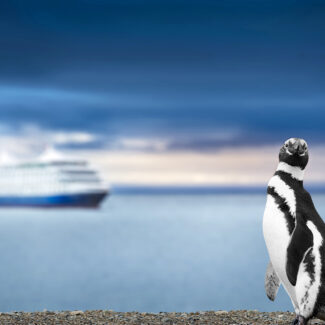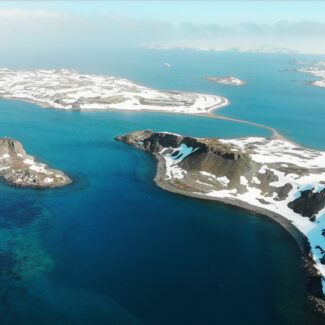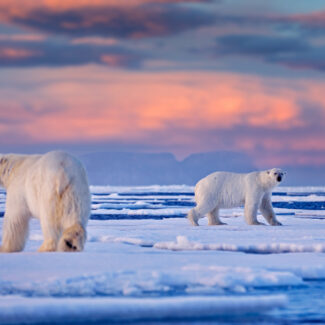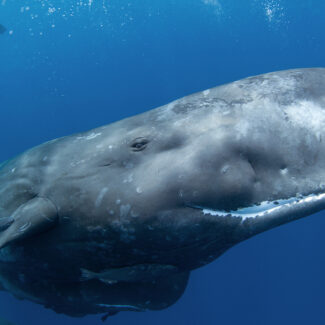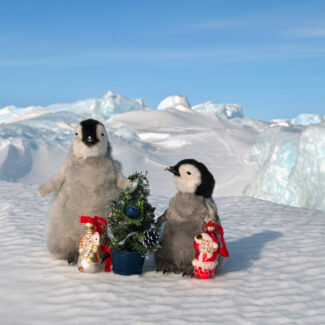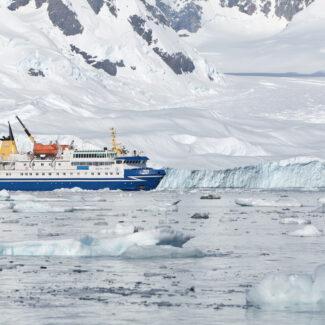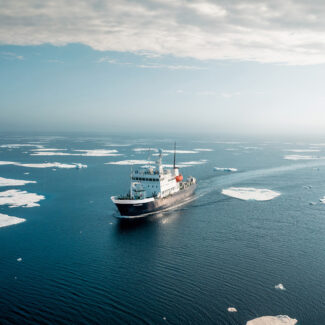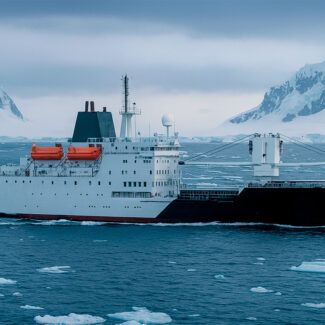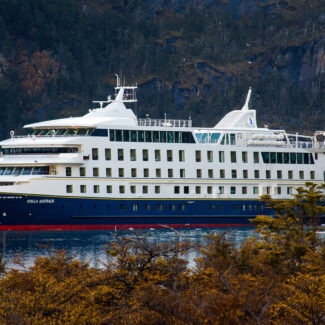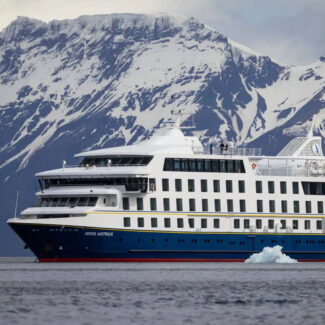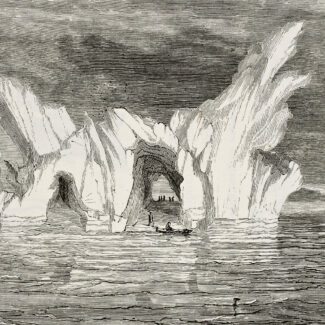A Guide To Arctic Whales & Whalewatching On An Arctic Cruise
Among the “signature” animals that make the Arctic such a spectacular wildlife-viewing destination are the cetaceans: the whales, which include (unsurprisingly) the heftiest of all beasts to call this cold and spectacular realm home. Some of the best whale-watching in the world goes down at the top of the world, with a trio of uniquely polar-adapted cetaceans being much sought-after and a number of other species plying these waters on a seasonal (and, as we’ll see, increasing) basis.
Read on to learn more about Arctic whales, from year-round specialists to seasonal visitors, and how you can maximize your chances of seeing them!
Toothed Whales Specialized for the Arctic: The Narwhal & Beluga
Two species of toothed whales are specially adapted to the Arctic: the narwhal and the beluga (or white whale). In fact, this pair is a closely related one: They’re the only members of that family of toothed whales known as the monodontids. Likely diverging about five million years ago, belugas and narwhals are known to hybridize on occasion, the result being (but of course) a “narluga.”
Both of these polar specialists, most stocks of which typically spend the entire year in and around Arctic waters, are absolutely unmistakable. The narwhal’s best-known feature is the mighty tusk of the male, an elongated, spear-like tooth—sometimes reaching nine feet long—which explains the animal’s nickname of “unicorn of the sea.” But even the (generally) tusk-less female—we say generally because tusked females aren’t unheard of, though rare—is distinctive, as narwhals show a pale, mottled hide in maturity and lack a dorsal fin.
Actually, the dorsal fin being absent is a characteristic of both narwhals and belugas, which instead bear a dorsal ridge; this is probably an adaptation for extensive time spent swimming directly beneath sea ice (and perhaps also a minimization of extremities that enhance heat loss). Along with the impressive proportions of body fat found in both species, this reflects the monodontids’ evolution as true, honest-to-goodness Arctic whales.
The dead giveaway of a beluga, of course, is the ivory-white color; the swollen-looking forehead, or “melon,” singularly flexible neck, and almost sluglike bodyplan are other distinctive features. So is the beluga’s vocal repertoire, which is more varied than any other cetacean’s that we know of. (The narwhal’s the unicorn of the sea; the beluga is the “sea canary.”)
What is the narwhal’s tusk for? Why do scientists reckon the beluga is such a varied vocalizer? What are the migration routes executed by both of these species? Well, you’ll find answers to those questions and plenty of other information in our dedicated profiles of these charismatic Arctic marine mammals: Check out our in-depth facts on the narwhal here and the beluga here!
Nicknamed “canaries of the sea” for their vocalizations, belugas navigate the frigid Arctic waters with intelligence and grace.
The Arctic’s Baleen-Whale Specialist: The Bowhead
One other cetacean is also an Arctic specialist, and it’s a massively larger creature than the monodontids. We’re talking about the bowhead whale, the only truly Arctic-adapted baleen whale in the world, and the biggest year-round resident of this top-of-the-world environment.
Bowheads may reach 60 or more feet long and 100 metric tons in weight, and their most striking physical characteristic is the sheer size of the head: It may be a third of the animal’s total length. That massive skull can be used as a battering ram to bust open sea ice—perhaps as much as two feet thick. The bowhead’s business end also boasts the longest baleen plates of any whale, sometimes more than 15 feet long. Like belugas and narwhals, bowheads have extensive body fat, and they also have the very thickest blubber of any whale: anywhere from 17 to 19 inches thick.
Like both the monodontids and its close relatives the northern and southern right whales (the bowhead is sometimes called the “Greenland right whale”), bowheads don’t have a dorsal fin. They are stocky and dark-bodied, with a distinctive white chin. And they are remarkably long-lived: Dating of harpoon points lodged in bowhead flesh show the whales can survive more than a century, and recent studies suggest some individuals may live to be more than 200 years old. This makes them the longest-lived known mammal.
All things considered, the bowhead is quite the superlative whale!
With a lifespan of over 200 years, the bowhead is the world’s longest-living mammal. It also has the thickest blubber of any whale, allowing it to thrive in Arctic waters.
Bowhead Range & Distribution
Some four stocks of bowhead whale are recognized, restricted year-round to Arctic and sub-Arctic waters. The bowhead’s geographic range covers the Bering, Chukchi, and Beaufort seas, the Sea of Okhotsk, the Canadian High Arctic and western Greenland, and the high-latitude ocean between eastern Greenland and the western Russian Arctic, including the Svalbard Archipelago.
Bowheads undergo yearly migrations in their Arctic/sub-Arctic homeland tied to sea ice: They winter mainly along the southern rim of the pack ice as well as in certain polynyas (large open-water “islands” within the pack), and follow the retreating, disintegrating front of the ice northward in spring and summer. As sea ice again thickens and expands in the mid- to late fall, bowheads retreat along its advancing edge southward to wintering grounds.
Bowhead Diet
Bowhead whales feed primarily on crustacean zooplankton, particularly krill and copepods, of which they may consume the rough equivalent of their body weight every year. Like other baleen whales, they are filter-feeders, sieving their tiny prey mainly out of the water column but sometimes also foraging along the mud of the seafloor in shallow waters.
Bowhead Conservation & Population Status
Long hunted by Native Arctic peoples, bowheads—prized for blubber, oil, and baleen—were hammered by commercial whaling that began in the 17th century or so and ramped up dramatically in the 1800s. By the first couple of decades of the 20th century, which saw the phaseout of commercial hunting of the species, the total global population of bowheads may have numbered fewer than 3,000 animals.
Today, bowhead whales have recovered somewhat from the ravages of historical commercial whaling, and their conservation status as classified on the IUCN Red List is “Least Concern.” That said, a number of bowhead populations are still much lower than their estimated pre-commercial-whaling numbers. The largest bowhead stock today is thought to be the Bering-Chuckchi-Beaufort Seas (Western Arctic) population, numbering more than 12,000 whales, while the Sea of Okhotsk and East Greenland-Svalbard-Barents Sea stocks are probably the smallest, numbering a few hundred each. The fourth population, Eastern Canada-West Greenland stock, may have close to 8,000 whales.
Once driven to near-extinction by commercial whaling, bowhead whales are a true conservation success story. They are now an inspiration for how we can protect other endangered species.
Other Cetaceans That Visit the Arctic/Sub-Arctic
A variety of other whales have historically ranged into Arctic and sub-Arctic waters on a seasonal basis, coinciding with the annual retreat and minimum extent of the sea ice that otherwise is generally inhospitable to all but the specially adapted bowhead, beluga, and narwhal. As climate change results in a shorter annual duration and lesser annual extent of this Arctic sea ice—and warming ocean waters—both indigenous observers and marine biologists are documenting greater northward expansion and seasonal presence of other cetaceans in Arctic seas.
Among the whales that appear to be expanding northward on a seasonal basis are humpbacks, minke, and fin whales as well as orcas (aka killer whales) and sperm whales. Humpback, fin, and minke whales appear to be increasingly foraying north of the Bering Strait in the Pacific Arctic, for example, with humpback and fin calves documented in recent years in the Chukchi Sea.
Blue whales in both the Northern and Southern hemispheres are known to travel into high-latitude waters during the summer, part of a yearly migration that sees them winter in tropical and subtropical latitudes. While generally found south of the Arctic proper, they’ve shown up as far north as Baffin Bay and the Svalbard Archipelago. While blue and fin whales both migrate into the Fram Strait between Greenland and Svalbard—a deep, seasonally ice-free connection between the Arctic Ocean and the Atlantic—to feed in summer and fall, some evidence suggests both species may be spending longer parts of the year in that region.
Blue whales are the largest animals ever to have lived, weighing up to 200 tons. These incredible giants visit the sub-Arctic waters during the summer.
Northward shifts in the distribution of krill and other prey connected to diminishing sea ice, longer open-water seasons, and rising ocean temperatures in the Arctic are likely behind the same sort of pattern being seen in certain baleen whales. And a similar food-motivated range expansion may be true for the sperm whale, largest (by far) of all toothed whales, which has also been increasingly documented in Arctic waters in recent years. Acoustic monitoring has recorded sperm whales as far north as 81 degrees N in Svalbard waters, and an increasing presence of the species in Baffin Bay, where significant concentrations of a favored sperm-whale prey species, the armhook squid, have also been observed.
Increasing incidence of orcas in the Arctic, meanwhile, has been well documented and generated many headlines, given the potential ramifications of such a formidable predator—an apex kingpin of the marine food web—expanding its range and occupation within this ecosystem. Orcas have long visited Arctic and sub-Arctic waters in pursuit of prey such as seals and bowhead whales, but have been limited, spatially and temporally, by sea ice, as killer whales are vulnerable to being trapped by shifting ice and drowning.
Orca avoidance of heavy sea ice has therefore made them only a fleeting seasonal visitor to the Arctic historically, but the decline in sea-ice thickness, extent, and duration seems to be allowing killer whales to expand their presence here. This may have big implications for narwhals, belugas, and bowhead whales, which seek refuge from orcas under pack ice—a dwindling escape option in the face of climate change—as well as for Inuit and other Arctic Natives, who may find themselves increasingly competing for such quarry with killer whales.
Where & When to See Whales at the Top of the World: Whalewatching on Arctic Cruises
Many of the Arctic itineraries we offer provide thrilling opportunities to potentially see whales, with the peak summer cruise-going season ideal given the extensive navigable water and notable wildlife concentrations. This is, after all, part of the prime annual window that sees the most diversity of cetaceans in these high-latitude waters, taking advantage of retreated sea ice and seasonal abundance of food.
Cruises to Svalbard, Greenland, and the Canadian Arctic Archipelago (as on our Northwest Passage tours) provide the potential to spy bowhead whales as well as (particularly in Svalbard) blue whales, with the possibility of seeing other great-whale visitors such as fins and sperm whales as well. From the St. Lawrence Seaway to the Canadian High Arctic, meanwhile, many of our Arctic cruises give you prime opportunity to glimpse belugas, among the most iconic of all whales.
From the V-shaped spout of the bowhead, the speckled getup and unicorn-style tusk of the narwhal, and snow-white hide of the beluga to the swordlike dorsal fin of a bull orca, distinctive characteristics of various Arctic and sub-Arctic cetaceans serve as I.D. giveaways.
Tours may include expert-led Zodiac excursions that heighten your chances of spotting whales and other wildlife. Our tour operators are all well-versed in the ethics and etiquette of responsible whale-watching, tenets of which include not intentionally approaching whales or otherwise coming within a certain minimum distance.
Whales are often easier to spot at the edge of the sea ice and in the open ocean. Whalewatching in the Arctic is a life-changing experience.
Disclaimer
Our travel guides are for informational purposes only. While we aim to provide accurate and up-to-date information, Antarctica Cruises makes no representations as to the accuracy or completeness of any information in our guides or found by following any link on this site.
Antarctica Cruises cannot and will not accept responsibility for any omissions or inaccuracies, or for any consequences arising therefrom, including any losses, injuries, or damages resulting from the display or use of this information.


